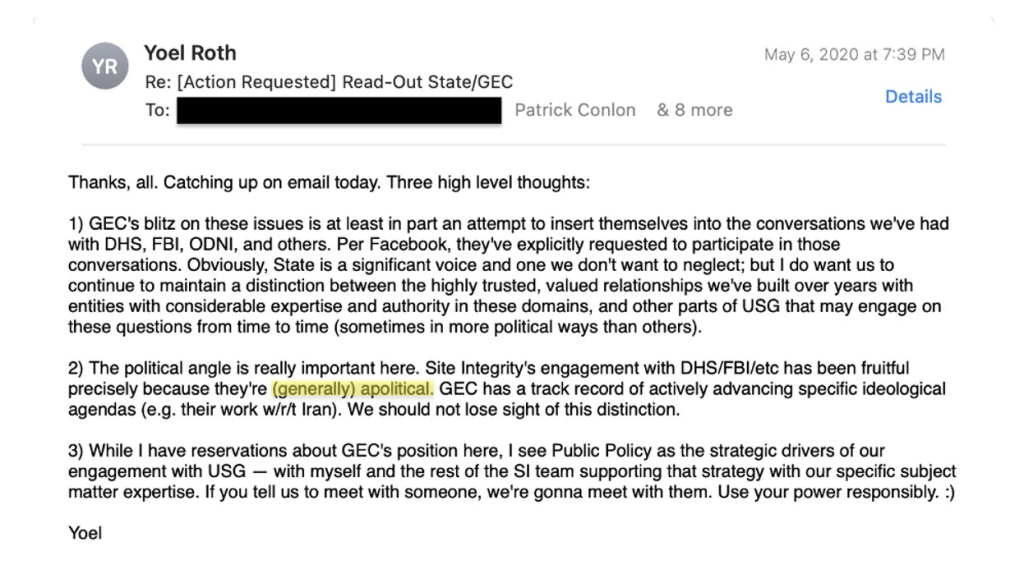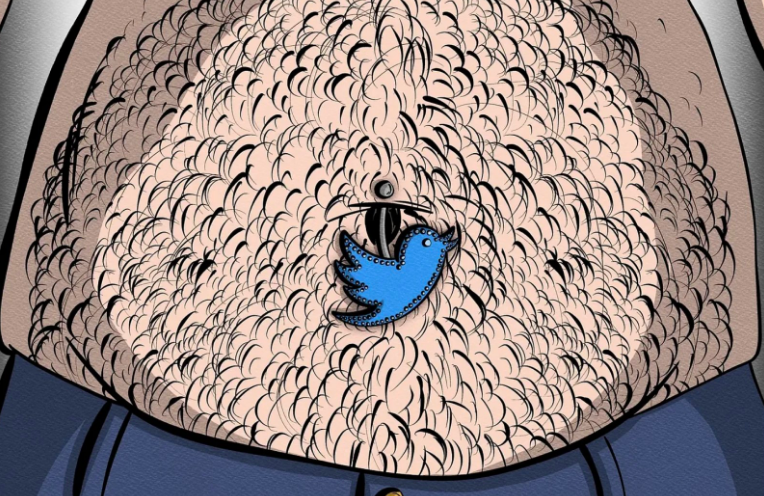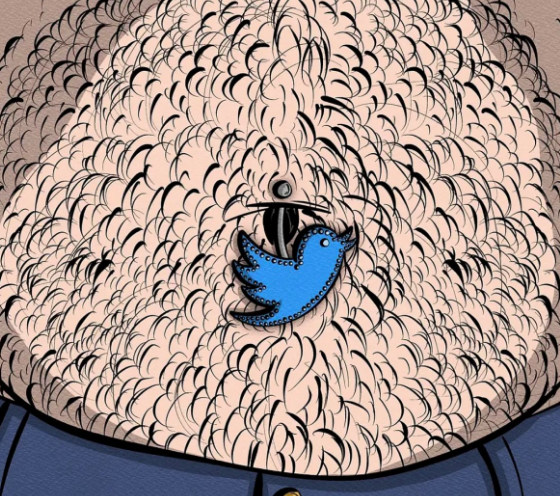The latest installment of the Twitter Files revealed the FBI’s desire for Twitter to rely on it to be the belly button of the U.S. government (USG). The first Twitter Files installment of 2023 revealed shared the events that led up to the intelligence community’s influence on Twitter. Following that installment, journalist Matt Taibbi released another, which revealed the Global Engagement Center’s (GEC) role.
Taibbi described the GEC as “a fledgling analytic/intelligence arms of the State Department,” and screenshots revealed how this new entity would go directly to the media. In one such instance, a report titled, Russian Disinformation Apparatus Taking Advantage of Coronavirus Concerns, was released, which wrecked a bit of havoc for Twitter.
1.THREAD: The Twitter Files
Twitter and the FBI “Belly Button” pic.twitter.com/nfOGQGlvUM— Matt Taibbi (@mtaibbi) January 3, 2023
Twitter’s then Trust and Safety head, Yoel Roth, pointed out the motives of Clemson’s Media Forensic Hub when it complained that Twitter hadn’t “made a Russia attribution” in some time.

Credit: Matt Taibbi

Credit: Matt Taibbi
Roth told researchers like Clemson that Twitter would be happy to work directly with them instead of the media. He was unsuccessful. Simultaneously, Twitter was trying to reduce the number of agencies that had access to Roth. Twitter’s then-policy director, Carlos Monje, pointed out that once Twitter gave these agencies, such as the Department of Homeland Security, access to Roth.
“If these folks are like House Homeland Committee and DHS, once we give them direct contact with Yoel, they will want to come back to him again and again,” Monje said.
Taibbi noted that the GEC report appeared to be based on DHS data that was circulated earlier that week. The data included accounts that followed two or more Chinese diplomatic accounts and ended up with a list “nearly 250,000” names long. The list included Canadian officials and a CNN account.

Credit: Matt Taibbi
In an email, Roth said that the GEC attempted to insert itself into conversations Twitter had with several government agencies, including the FBI and DHS. The GEC began to agree to loop Twitter in before going public; however, the agency used a technique that trapped Twitter previously.
“The delta between when they share material and when they go to the press continues to be problematic,” a comms official wrote, adding that they primed the media to be “curios and inquisitive of this dynamic, too.”

Credit: Matt Taibbi
This led to Twitter’s disputing a State Department claim that China coordinated coronavirus disinformation accounts. The FBI then informed Twitter that the GEC wanted to be included in their regular “industry call” between companies like Twitter and Facebook and the DHS and FBI. At first, Twitter didn’t want to go this route. Executives at Facebook and Google were united with Twitter in its opposition to the GEC’s inclusion.
“The GEC’s mandate for offensive IO to promote American interests. The relative lack of discretion and caution from senior GEC leadership in sharing reports/analysis based on shaky methodology. A limited track record of successful collaboration with industry.”
Roth noted that an actor such as GEC being introduced to a stable and trusted group of practitioners and experts, especially with the election heating up, posed major risks.

Credit: Matt Taibbi
Roth added that another reason was that the DHS and FBI were “apolitical,” whereas the GEC was “political.”
“GEC has a track record of actively advancing specific ideological agendas (e.g., their work w/r/t Iran). We should not lose sight of this distinction,” Roth wrote.

Credit: Matt Taibbi
The FBI argued for a compromise solution that would allow other U.S. government (USG) agencies to participate in the industry calls, with the FBI and DHS acting as sole conduits. When Roth reached out to FBI agent Elvis Chan with concerns, Chan reassured the Twitter executive that it would be a “one-way” channel and “State/GEC, NSA, and CIA have expressed interest in being allowed on in listen mode only.”
“We can give you everything we’re seeing from the FBI and USIC agencies,” Chan told Roth, adding that the DHS agency Cybersecurity and Infrastructure Security Agency (CISA) “will know what’s going on in each state.” Chan then asked if the industry could “rely on the FBI to be the belly button of the USG.”

Credit: Matt Taibbi
The group eventually chose Signal due to its operational security. Following that, Twitter began taking requests from various government bodies starting with the Senate Intel Committee (SSCI), which needed reassurance that Twitter was taking FBI direction.
Twitter also received various requests from officials wanting individuals they didn’t like to be banned from the platform. In the screenshot below, the office for Democrat and House Intel Committee chief Adam Schiff asked Twitter to ban journalist Paul Sperry.

Credit: Matt Taibbi
At the time, Twitter refused. However, Sperry was later suspended. “No, this isn’t feasible/we don’t do this,” Twitter replied.

Twitter honored many of the requests, including those from the GEC, to ban accounts the GEC identified as “GRU-controlled” and linked “to the Russian government.”
A former CIA staffer working at Twitter called the GEC requests “Our window on that is closing,” which meant that the days Twitter could say no to serious requests were over. In the Twitter Files that were released earlier today, Taibbi noted that in public, Twitter would remove content at its “sole discretion.”
Privately, the platform would “off-board” anything that was “identified by the U.S. intelligence community as state-sponsored entity conducting cyber-operations.” That was in 2017. By 2020, agencies were flooding Twitter with “identifications” or users that it wanted Twitter to remove.

Credit: Matt Taibbi
Taibbi pointed out that some reports were only a paragraph long and that Twitter would be forwarded an Excel document without further explanation. Twitter was also warned about the publicity surrounding a book written by former Ukraine prosecutor Viktor Shokhin, who alleged “corruption by the U.S. government” – specifically by Joe Biden.
Screenshots reveal that by mere weeks before the 2020 election, Twitter was so confused by the multiple streams of incoming requests that staffers had to ask the FBI which was which.

Credit: Matt Taibbi
Taibbi noted that this led to the situation described in an earlier Twitter Files release by Michael Shellenberger on December 19, 2022.
In that release, it was revealed that Twitter was paid $3,415,323. Taibbi noted that Twitter wasn’t just paid but underpaid for the amount of work it did for the government.
Your feedback is welcome. If you have any comments or concerns or see a typo, you can email me at johnna@teslarati.com. You can also reach me on Twitter at @JohnnaCrider1.
Teslarati is now on TikTok. Follow us for interactive news & more. Teslarati is now on TikTok. Follow us for interactive news & more. You can also follow Teslarati on LinkedIn, Twitter, Instagram, and Facebook.

News
Tesla stands to win big from potential adjustment to autonomous vehicle limitations
Enabling scale, innovation, and profitability in a sector that is growing quickly would benefit Tesla significantly, especially as it has established itself as a leader.

Tesla stands to be a big winner from a potential easing of limitations on autonomous vehicle development, as the United States government could back off from the restrictions placed on companies developing self-driving car programs.
The U.S. House Energy and Commerce subcommittee will hold a hearing later this month that will aim to accelerate the deployment of autonomous vehicles. There are several key proposals that could impact the development of self-driving cars and potentially accelerate the deployment of this technology across the country.
These key proposals include raising the NHTSA’s exemption cap from 2,500 to 90,000 vehicles per year per automaker, preempting state-level regulations on autonomous vehicle systems, and mandating NHTSA guidelines for calibrating advanced driver assistance systems (ADAS).
Congress, to this point, has been divided on AV rules, with past bills like the 2017 House-passed measure stalling in the Senate. Recent pushes come from automakers urging the Trump administration to act faster amid competition from Chinese companies.
Companies like Tesla, who launched a Robotaxi service in Austin and the Bay Area last year, and Alphabet’s Waymo are highlighted as potential beneficiaries from lighter sanctions on AV development.
The NHTSA recently pledged to adopt a quicker exemption review for autonomous vehicle companies, and supporters of self-driving tech argue this will boost U.S. innovation, while critics are concerned about safety and job risks.
How Tesla Could Benefit from the Proposed Legislation
Tesla, under CEO Elon Musk’s leadership, has positioned itself as a pioneer in autonomous driving technology with its Full Self-Driving software and ambitious Robotaxi plans, including the Cybercab, which was unveiled in late 2024.
The draft legislation under consideration by the U.S. House subcommittee could provide Tesla with significant advantages, potentially transforming its operational and financial landscape.
NHTSA Exemption Cap Increase
First, the proposed increase in the NHTSA exemption cap from 2,500 to 90,000 vehicles annually would allow Tesla to scale up development dramatically.
Currently, regulatory hurdles limit how many fully autonomous vehicles can hit the roads without exhaustive approvals. For Tesla, this means accelerating the rollout of its robotaxi fleet, which Musk envisions as a network of millions of vehicles generating recurring revenue through ride-hailing. With Tesla’s vast existing fleet of over 6 million vehicles equipped with FSD hardware, a higher cap could enable rapid conversion and deployment, turning parked cars into profit centers overnight.
Preempting State Regulations
A united Federal framework would be created if it could preempt State regulations, eliminating the patchwork of rules that currently complicate interstate operations. Tesla has faced scrutiny and restrictions in states like California, especially as it has faced harsh criticism through imposed testing limits.
A federal override of State-level rules would reduce legal battles, compliance costs, and delays, allowing Tesla to expand services nationwide more seamlessly.
This is crucial for Tesla’s growth strategy, as it operates in multiple markets and aims for a coast-to-coast Robotaxi network, competing directly with Waymo’s city-specific expansions.
Bringing Safety Standards to the Present Day
Innovation in the passenger transportation sector has continued to outpace both State and Federal-level legislation, which has caused a lag in the development of many things, most notably, self-driving technology.
Updating these outdated safety standards, especially waiving requirements for steering wheels or mirrors, directly benefits Tesla’s innovative designs. Tesla wanted to ship Cybertruck without side mirrors, but Federal regulations required the company to equip the pickup with them.
Cybercab is also planned to be released without a steering wheel or pedals, and is tailored for full autonomy, but current rules would mandate human-ready features.
Streamlined NHTSA reviews would further expedite approvals, addressing Tesla’s complaints about bureaucratic slowdowns. In a letter written in June to the Trump Administration, automakers, including Tesla, urged faster action, and this legislation could deliver it.
In Summary
This legislation represents a potential regulatory tailwind for Tesla, but it still relies on the government to put forth action to make things easier from a regulatory perspective. Enabling scale, innovation, and profitability in a sector that is growing quickly would benefit Tesla significantly, especially as it has established itself as a leader.
News
Nvidia CEO Jensen Huang explains difference between Tesla FSD and Alpamayo
“Tesla’s FSD stack is completely world-class,” the Nvidia CEO said.

NVIDIA CEO Jensen Huang has offered high praise for Tesla’s Full Self-Driving (FSD) system during a Q&A at CES 2026, calling it “world-class” and “state-of-the-art” in design, training, and performance.
More importantly, he also shared some insights about the key differences between FSD and Nvidia’s recently announced Alpamayo system.
Jensen Huang’s praise for Tesla FSD
Nvidia made headlines at CES following its announcement of Alpamayo, which uses artificial intelligence to accelerate the development of autonomous driving solutions. Due to its focus on AI, many started speculating that Alpamayo would be a direct rival to FSD. This was somewhat addressed by Elon Musk, who predicted that “they will find that it’s easy to get to 99% and then super hard to solve the long tail of the distribution.”
During his Q&A, Nvidia CEO Jensen Huang was asked about the difference between FSD and Alpamayo. His response was extensive:
“Tesla’s FSD stack is completely world-class. They’ve been working on it for quite some time. It’s world-class not only in the number of miles it’s accumulated, but in the way it’s designed, the way they do training, data collection, curation, synthetic data generation, and all of their simulation technologies.
“Of course, the latest generation is end-to-end Full Self-Driving—meaning it’s one large model trained end to end. And so… Elon’s AD system is, in every way, 100% state-of-the-art. I’m really quite impressed by the technology. I have it, and I drive it in our house, and it works incredibly well,” the Nvidia CEO said.
Nvidia’s platform approach vs Tesla’s integration
Huang also stated that Nvidia’s Alpamayo system was built around a fundamentally different philosophy from Tesla’s. Rather than developing self-driving cars itself, Nvidia supplies the full autonomous technology stack for other companies to use.
“Nvidia doesn’t build self-driving cars. We build the full stack so others can,” Huang said, explaining that Nvidia provides separate systems for training, simulation, and in-vehicle computing, all supported by shared software.
He added that customers can adopt as much or as little of the platform as they need, noting that Nvidia works across the industry, including with Tesla on training systems and companies like Waymo, XPeng, and Nuro on vehicle computing.
“So our system is really quite pervasive because we’re a technology platform provider. That’s the primary difference. There’s no question in our mind that, of the billion cars on the road today, in another 10 years’ time, hundreds of millions of them will have great autonomous capability. This is likely one of the largest, fastest-growing technology industries over the next decade.”
He also emphasized Nvidia’s open approach, saying the company open-sources its models and helps partners train their own systems. “We’re not a self-driving car company. We’re enabling the autonomous industry,” Huang said.
Elon Musk
Elon Musk confirms xAI’s purchase of five 380 MW natural gas turbines
The deal, which was confirmed by Musk on X, highlights xAI’s effort to aggressively scale its operations.

xAI, Elon Musk’s artificial intelligence startup, has purchased five additional 380 MW natural gas turbines from South Korea’s Doosan Enerbility to power its growing supercomputer clusters.
The deal, which was confirmed by Musk on X, highlights xAI’s effort to aggressively scale its operations.
xAI’s turbine deal details
News of xAI’s new turbines was shared on social media platform X, with user @SemiAnalysis_ stating that the turbines were produced by South Korea’s Doosan Enerbility. As noted in an Asian Business Daily report, Doosan Enerbility announced last October that it signed a contract to supply two 380 MW gas turbines for a major U.S. tech company. Doosan later noted in December that it secured an order for three more 380 MW gas turbines.
As per the X user, the gas turbines would power an additional 600,000+ GB200 NVL72 equivalent size cluster. This should make xAI’s facilities among the largest in the world. In a reply, Elon Musk confirmed that xAI did purchase the turbines. “True,” Musk wrote in a post on X.
xAI’s ambitions
Recent reports have indicated that xAI closed an upsized $20 billion Series E funding round, exceeding the initial $15 billion target to fuel rapid infrastructure scaling and AI product development. The funding, as per the AI startup, “will accelerate our world-leading infrastructure buildout, enable the rapid development and deployment of transformative AI products.”
The company also teased the rollout of its upcoming frontier AI model. “Looking ahead, Grok 5 is currently in training, and we are focused on launching innovative new consumer and enterprise products that harness the power of Grok, Colossus, and 𝕏 to transform how we live, work, and play,” xAI wrote in a post on its website.










